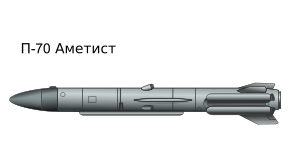Cruise Missile
P-70 Ametist
India has acquired around 50+ all are reserved due to short range but are ready to be used since last upgradation in 90's
Type | Anti-shipping missile |
Place of origin | |
Service history | |
In service | 1968-1995 |
Used by | |
Production history | |
Manufacturer | NPO Mashinostroyeniye (Chelomei) |
Specifications | |
Weight | 7,700 lb ( |
Length | 23.0 ft ( |
Warhead | HE or 200kt nuclear |
Warhead weight | 1,170 lb ( |
Propellant | Solid fuel |
Operational range | |
Speed | Mach 0.9 |
Launch platform | |
The P-70 Ametist (NATO reporting name SS-N-7 Starbright, GRAU designation 4K66; Russian: П-70 «Аметист» 'Amethyst') was an anti-shipping missile carried by Soviet Charlie-I submarines. A sub-launched version of the SS-N-2 'Styx ', it was soon succeeded by the P-120 Malakhit (SS-N-9 'Siren').
Design
The P-15M was fitted with an L band sensor and a new altimeter radar both developed for the 'Siren', but there was no room for a datalink in the smaller 'Styx'. Folding wings were added to reduce the size of the missile, and the missile can be launched at a maximum depth of 30 meter .
The short range of the P-70 meant that it did not need mid-course updates from a radar on the submarine, so it could be fired whilst submerged. This more than made up for its lack of range compared to the 'Shaddock'.
Operational history
The P-70 went into service with the Soviet Navy on the first Charlie I, on June 3, 1968. About 200 were produced.
Operators


No comments:
Post a Comment